If you’re planning a trip to Medellin, it can be somewhat challenging because the destination is so new on the travel scene, and authentic and insightful information can be lacking. It is, however, growing in popularity and many more people are now traveling to Medellin, including a growing travel blogger community that often just visits briefly and writes superficially about the city.
I wanted to do something different though… I wanted to write about this city that I know and love from a more authentic, respectful, and honest perspective. I’ve spent a few years now living in Medellin, Colombia, I know the place extremely well, and in a way that goes beyond the surface level.
Since you’re here, I want to help you plan a better trip to Medellin with some of these important tips or insights… These are the types of things you should know when traveling to Medellin for the first time, the types of things that can make your trip amazing, unforgettable, and go beyond the stereotypes, or at least beyond the typical advice I see others writing online.
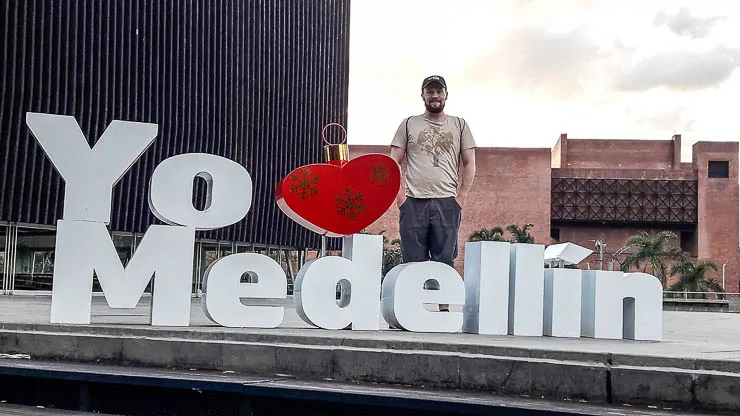
In this comprehensive Medellin travel guide, we are going to be covering a bunch of travel tips ranging from where to stay, what to eat, safety in Medellin, how to deal with money, the Spanish language, and so much more.
Are you ready? Buckle up, this is a big one… Let’s get on with these 13 things you should know when traveling to Medellin for the first time — and don’t miss #13 as it covers the critical issue of safety and security.
If you’re pressed for time, you can also get these travel tips and much more delivered straight to your inbox for future reading or reference with my FREE Medellin Travel Guide:
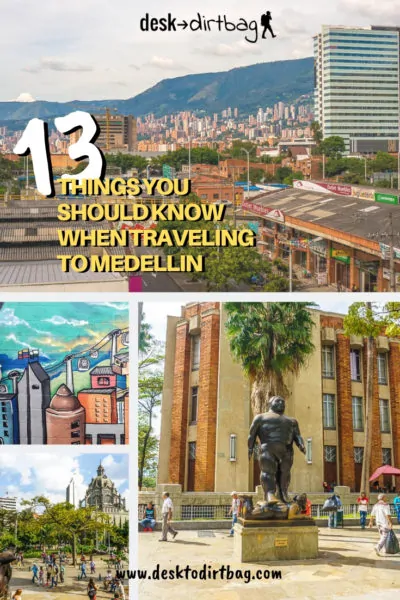
Where to Stay in Medellin
Ninety percent (or more) of the foreign travelers that come to Medellin stay in Poblado, but there are a number of pretty awesome barrios or neighborhoods to stay in Medellin that are worth considering.
My top picks for where to stay beyond Poblado include Laureles (my favorite neighborhood) and Envigado (although you won’t find any hostels here). The Estadio neighborhood is probably the second most popular area for budget travelers with a myriad of great lodging choices available.
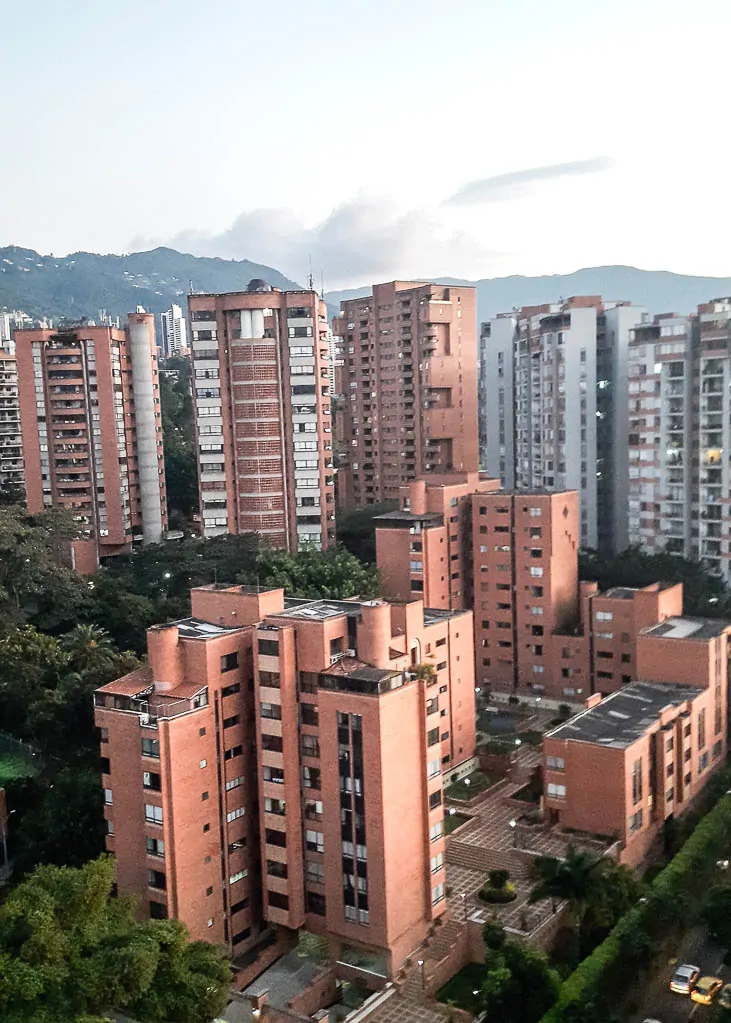
Finally, there is also El Centro, which may appeal to those budget travelers who like more off-the-beaten-path type experiences that many gringos never explore or even appreciate (there are actually a lot of cool things in El Centro, to be honest).
If you’re staying in Poblado, I’d recommend the Manila or Provenza sectors, or the Golden Mile if you’re looking for the high end.
Poblado:
#1 Hostel in Poblado: Los Patios Boutique Hostel (Manila)
#1 Budget Hotel in Poblado: Kolor Hotel Boutique (Provenza)
#1 Mid-Range Hotel in Poblado: Celestino Boutique Hotel (Parque Lleras)
#1 Luxury Hotel in Poblado: Medellin Marriott Hotel (Milla de Oro – the Golden Mile) — Read my in-depth review
Laureles:
#1 Hostel in Laureles: Backpackers Inn Medellin
#1 Budget Hotel in Laureles: Hotel Pomarosa
#1 Mid-Range Hotel in Laureles: Inntu Hotel
Estadio:
#1 Hostel in Estadio: Hostal Cattleya Medellin
#1 Budget Hotel in Estadio: Obo Hotel
#1 Mid-Range Hotel in Estadio: El Portón de San Joaquin
Envigado:
#1 Best Hotel in Envigado: Arame Hotel (it’s actually the only hotel, but it’s good). While not technically iN Envigado, I would still recommend the Fairfield by Marriott Sabaneta for a great mid-price hotel!
El Centro:
#1 Hostel in El Centro: Medallo Social Hostal (Boston)
#1 Budget Hotel in El Centro: Hotel Gallery (Bombona)
For longer stays, my top recommendation is Airbnb (new users can get a free travel credit here), also don’t overlook travel hacking to get points for free hotel stays (like the expensive Marriott), and be sure to read my guide to finding cheap accommodation.
If you need more help trying to decide on the best neighborhood, be sure to read more about where to stay in Medellin or my comprehensive guide to the best Medellin hostels.
Look Beyond Poblado
Poblado is a popular place to stay for foreigners in Medellin… But I’ve got a little secret for you: I don’t particularly love Poblado. I’ve stayed there before, I visit every once in a while, but it just isn’t my favorite neighborhood. I mention this Medellin travel tip because it can dramatically change your perspective and experience of the city, so pay close attention.
Poblado is right for some travelers and very wrong for others.
Every travel blogger who comes through for a couple of days stays in Poblado, of course, and they go on to write about Poblado, and then everyone else who comes through after follows in their footsteps. It becomes a sort of feedback loop.
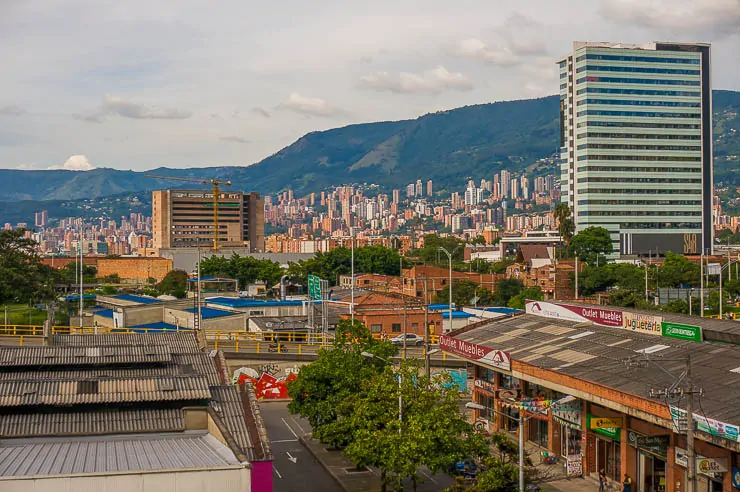
One of the most prominent travel bloggers recently traveled to Medellin for the first time and went on to write about how Medellin didn’t feel “real” and was just full of chains like Dunkin’ Donuts or Domino’s Pizza.
Another prominent travel blogger said (privately, at least) that he couldn’t see what people really liked about Medellin… And left town with a sour taste in his mouth.
I can understand their perspective because both of these guys were staying in Poblado, in the middle of gringolandia, constantly surrounded by gringos, socializing with gringos, and only left that bubble on organized tours or excursions… Seriously.
These self-proclaimed travel experts were so far from the “authentic” Medellin that they missed the real draw here and what makes this place special. Then other travelers like you read their advice about where to stay and what to do and end up leaving slightly disappointed or let down. That’s a shame.
If you are looking for any semblance of the “real” Medellin, then you should NOT stay in Poblado. Look, it’s a fine place to visit (I do go there once in a while myself!) but I wouldn’t (and don’t) make it my home base. If you do stay in Poblado (totally fine, if it’s right for you), at least make a concerted effort to get out of that bubble on a regular basis.
Medellin is not Poblado, and Poblado is not Medellin.
It all depends on what type of traveler you are… Do you like to be surrounded by English and other travelers? Do you feel uncomfortable only seeing locals and hearing Spanish? You definitely want Poblado.
Personally, I travel to interact with locals, practice the language, learn from people unlike me, etc, and not be surrounded by other travelers doing the same thing as me. That’s part of why I travel. If I wanted to hang out with other foreigners, speak English, and eat the same chain food as always, I would have just stayed home and never left.
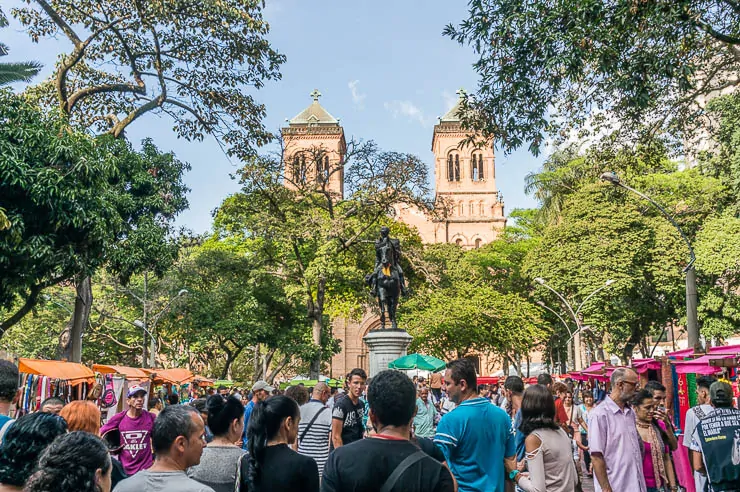
Here’s a thought exercise to determine what kind of traveler you are:
- If you go to New York City, do you think Times Square is the best place and never leave or are you more interested in neighborhoods like the Meatpacking District, the Lower East Side, Harlem, etc? Do you want to eat where New Yorkers eat or where the tourist bus lets you off?
- If you go to Las Vegas do you prefer to stay on the Strip or in the Old Town / Fremont area?
- If you go to Cancun do you stay in an all-inclusive resort and only leave on organized Cancun tours or do you prefer to stay in town and experience more of the authentic Cancun?
If you answered the former to any of those, then Poblado is right for you, if you answered the latter, then it is wrong for you.
Poblado is great for nightlife, foodies, and people who like a little luxury at a more affordable price, but if you want to get off the beaten path (even slightly), have a more local experience, talk with Colombians, and so forth, then it is best to look elsewhere.
Honestly, you can get nightlife, food, or even a bit of luxury in almost any cool neighborhood in Medellin.
Getting Around Medellin
Public Transport: Medellin has a pretty excellent public transportation system. Granted it isn’t on the scale of places like Mexico City, but it is nonetheless quite impressive. It features a two-line above-ground metro system (subway) which connects to an integrated streetcar route, gondola system (MetroCable), and bus rapid transit (BRT) lines known as MetroPlus.
If you are staying in any of the principal areas, you will have easy access to the public transportation system. You should get a Tarjeta Civica as soon as you can upon arrival which is available from a few different metro stations like San Antonio.
You can get the Tarjeta Civica for free with your passport. This allows you to use the integrated transportation system and pay reduced prices for connecting services.
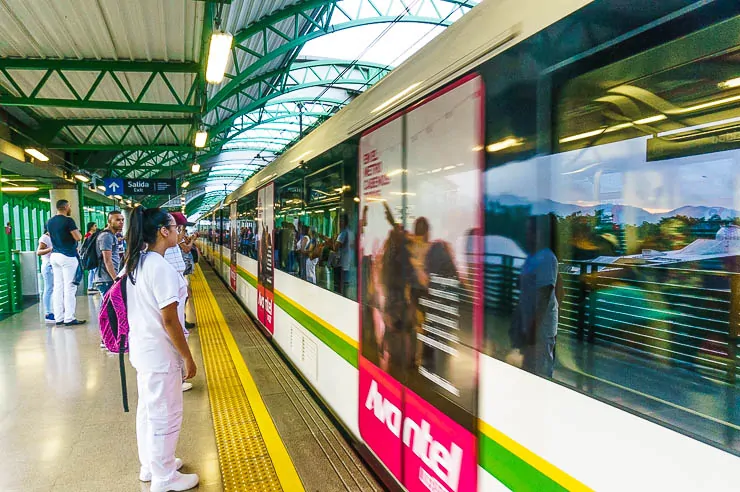
Taxis: Taxis are available basically everywhere in Medellin. You can easily flag down taxis pretty much anywhere, although this is not always recommended due to safety issues (more on that later). A better bet is to try and use either an official taxi stand or (if you have a SIM card) to use an app like Cabify to call a taxi with your GPS location.
That being said, I generally don’t worry about flagging down taxis from the street during the daytime, but I am more cautious after dark.
It is rare, but the majority of problems that people have here in Medellin happen while in taxis. There are some bad apples out there who work with robbers and tip them off when they have a good target (you) in their cab.
The rules of using taxis here are to sit in the back, keep the windows almost all the way up, lock the doors, and never use your phone or show valuables in the back seat.
Uber: Uber is actually illegal here in Colombia but that doesn’t stop people from driving for them or utilizing the service. I tend to trust Uber drivers more than taxi drivers, but using Uber can have its own complications here if drivers are reluctant to stop near you (if they see transit police nearby). Normally, they will want you to sit up front with them (like a friend) rather than alone in the back (like a taxi), which is done to avoid problems with the law.
Bike Share: There is a growing bike share service here in Medellin called Encicla. With the previously mentioned Tarjeta Civica, you can use the bike share service here in Medellin and Envigado by enrolling in Encicla online. Neighborhoods like Laureles or Estadio are much more conducive to this type of transport since it is flat and has bike lanes. You must enroll for Encicla online with your Tarjeta Civica, so it is only practical for longer stays in Medellin.
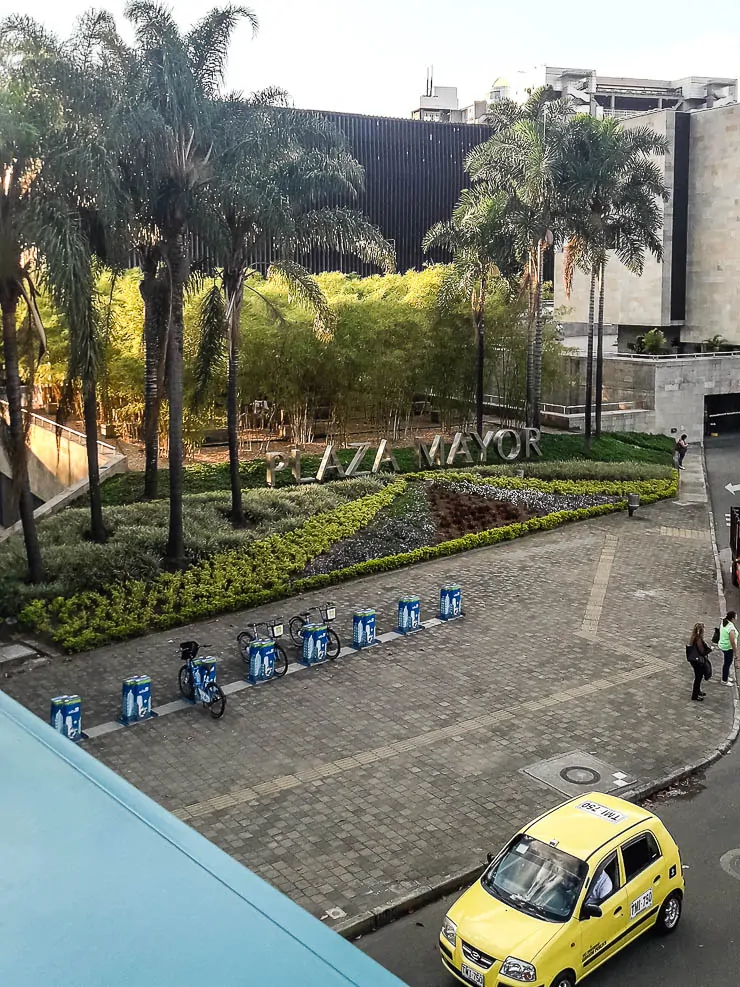
Getting to Medellin from the Airport: The Jose Maria Cordova Airport is actually about an hour outside of Medellin (don’t be fooled by that airport in the middle of town, that one is not used for international flights). Getting from the airport is pretty easy, you’ve got options for either a bus (cheapest), shared town car (cheap), or private town car (best).
I pretty much always go by private car when coming from the airport to Medellin. They go door to door, it’s a stress-free way to travel, and it isn’t expensive. The rate is fixed based on destination and you can expect to spend about $20.
Alternatively, you can ask at the airport for a colectivo (they are the same white cars) which charge about $5 (22.000 pesos) and need four passengers, and will drop you off at the San Diego Shopping Mall, from there you can grab a taxi to your final destination.
Getting to the Airport from Medellin: In terms of going to the airport from town, I prefer to go by shared town car which you can grab from the San Diego Shopping Mall at the base of Las Palmas (go here by taxi and tell the driver “los colectivos al aerpuerto”. The shared ride will wait to fill up with four passengers and costs about $5 per person. Unless you’ve got a really weird flight time, I’ve never had to wait more than 10-15 minutes to leave.
These cars are much better than the bus, believe me, don’t go by bus — it’s slower, more nauseating, and doesn’t save you much money. If you’re worried about the whole airport and transport thing, you can also book a private car in advance.
Eat Like a Local
There is a growing and vibrant food scene here in Medellin which is one of the things that makes it so great to live here and call this place home over the long term, but this type of food is definitely expensive for local standards (but cheaper than home standards).
One way you can save a lot of money and eat well though (instead of eating at these more upscale restaurants) is to eat as the locals do…
This is especially true for lunch and the set menus of the day “menu del dia” where you can score good food including soup, main dish (salad, rice, meat, and maybe a plantain), along with fresh fruit juice for about $3. Perhaps one of the best reasons to visit Colombia is just to try some of the incredibly exotic Colombian fruits and all the juices!
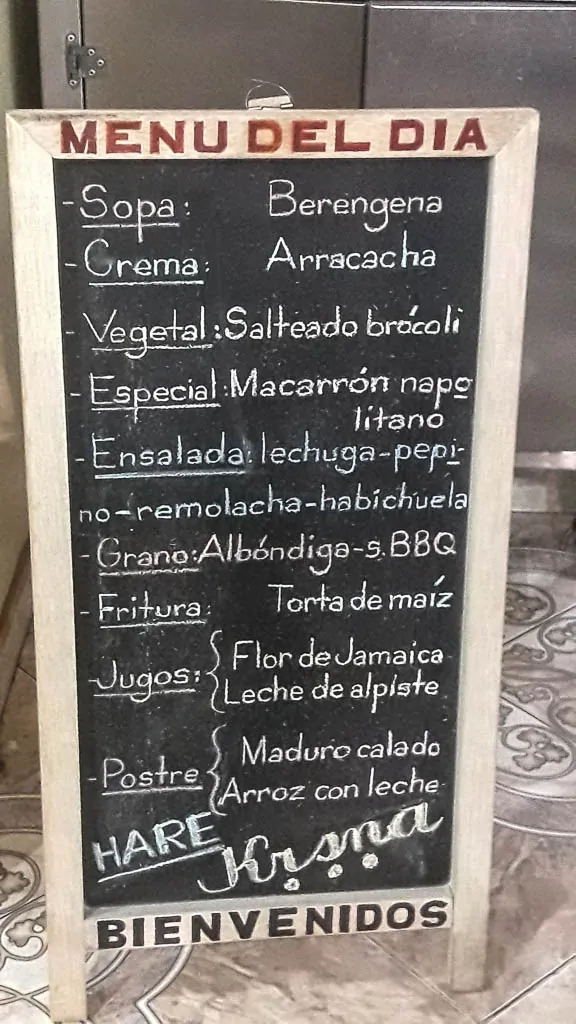
That’s a pretty hard price to beat… If you eat in a restaurant you can expect to pay around $8 just for comparison.
At these same local restaurants, you will usually find a cheap and hearty breakfast (eggs, arepa with cheese, and coffee) for about the same price as lunch.
Dinner, on the other hand, doesn’t have these cheap and affordable menus of the day, unfortunately, as they all close up shop after lunch. In this case, you’ll need to hit up a restaurant — there are some local restaurants where you can order off the menu — or go from some fast food (also very popular here) or street food.
Be sure to consider going on a traditional food tour while here if you want a great introduction to Paisa food.
The street food choices can be pretty good and definitely cheap, but it pays to ask for tips from someone in the neighborhood. What most locals do for dinner is to eat an arepa at home, but if they have to grab something, they will usually get an empanada or pastel (stuffed meat pies, basically) to eat with a coffee.
Lunch here is the biggest meal of the day and dinner is relatively modest.
Read more about what to eat with my guide to Colombian food.
Do You Need Spanish in Medellin?
Tourism in Medellin is still relatively new… This isn’t like going to Cancun or something where everybody at your resort speaks English. Now, do you need Spanish here? No, plenty of people get by. But you should try to have as much Spanish as possible before you arrive.
It will make your life here a lot easier in terms of getting around, getting what you need, etc. Not to mention the fact that the locals are friendly! People all over Colombia really like to chat with foreigners… If you’re open to it, they will chat with you.
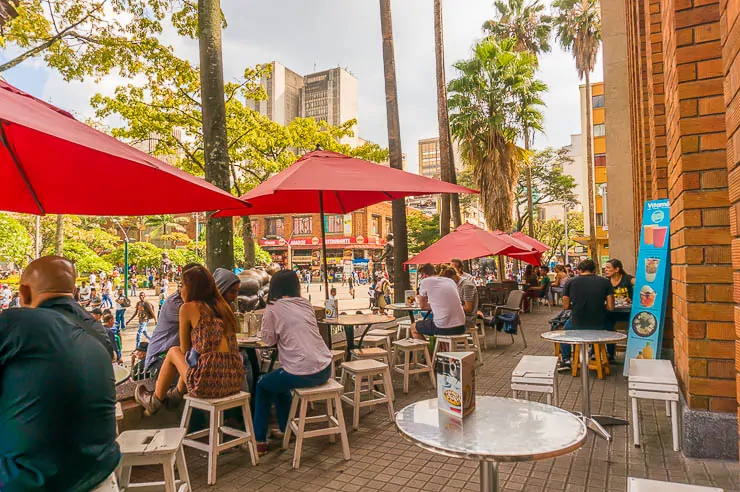
Small talk is like a sport here, seriously. Expect people to spend five minutes greeting one another asking how they woke up, what’s new, and beyond, and another five minutes (at least) to say goodbye. It’s almost comical sometimes.
You will find that if push comes to shove, there are quite a lot of local Paisas that do speak English — often way better than your Spanish — but they are too shy or timid to use it until like 20 minutes into the struggling conversation.
In summary, you don’t need Spanish, but you should have at least the basics, and the more you have the better. Medellin is a great place to study Spanish, as well, in my opinion, thanks to the friendly locals and the relative clarity of the local accent.
Read more about the best resources to learn Spanish on your own.
About That Medellin Weather
Medellin has gotten the nickname “La Ciudad de Eterna Primavera” — the City of Eternal Spring. This nickname comes from the fact that the city is quite green, flowers are always in bloom, and the weather is supposed to be moderate thanks to its elevation of 4,905 feet.
I always joke though that it is more like the City of Eternal Summer. According to locals, the temperatures have increased quite a bit in recent years, and back in the day Medellin had truly incredible weather when it was never too hot or too cold, and that Eternal Spring name really made sense (although it still makes sense with year-round flowers).
Of course, the temperature and humidity here are nothing like it is on the Colombian coast, and for a city in the tropics, it is a pretty agreeable climate. But the daytime weather is more often between 80 and 90 degrees year-round… Those average annual temperatures of 72 or rarely exceeding 78 like you might have read online seem to be a thing of the past.
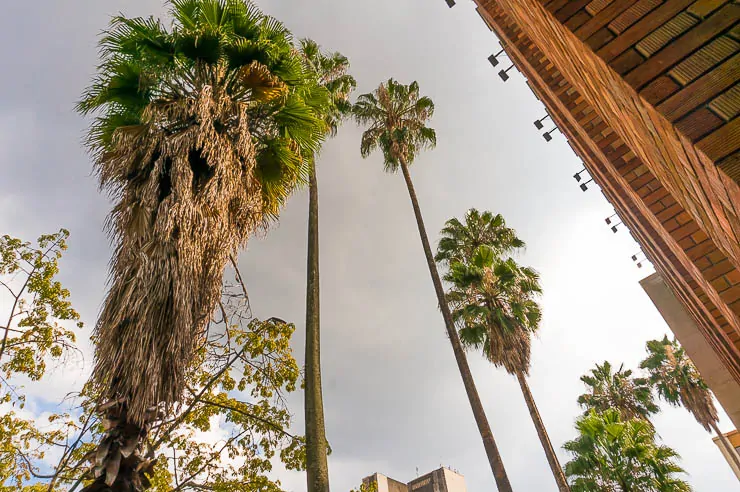
For me, as a fair-weathered Seattlite, the temperatures from about 11 am to 3 pm are way too hot and I try to avoid going out, or if I do, I stay in the shade while walking down the street. But the temperatures at night here are pretty much perfect. For reference, I basically always use t-shirts even at night and don’t sleep with anything more than a bedsheet and my underwear.
There are basically only two seasons here in Medellin: dry and rainy. They also used to be much more predictable, but have gotten a little more off-kilter and unpredictable lately. They should be:
- December to March = Dry Season,
- April to May = Rainy Season,
- June to August = Dry Season, and
- September to November = Rainy Season.
That being said, if you come to Medellin in the rainy season, it isn’t a deal-breaker, because the rain is fairly predictable, striking in the mid to late afternoon. More often than not, it rains really hard and goes away pretty quickly too. That means you can still usually get out in the evening for dinner or drinks after the rain.
Keep in mind that due to its location in the tropics, sunrise and sunset are basically consistent year-round. It gets light at about 6:30 am and dark at 6:30 pm. The early darkness can affect safety which we’ll discuss below.
Read more about the best time to visit Colombia for weather and tourist crowds.
What to Wear in Medellin
So, given the (mostly) beautiful weather here in Medellin, what should you wear? At first blush, it seems like perfect shorts and t-shirt weather… And it really is! But everyone says not to wear shorts, t-shirts, and flip-flops here because no locals wear that and you will stick out like a sore thumb.
Honestly, unless you’ve got black hair and mestizo features, you’re probably going to stick out no matter what you wear.
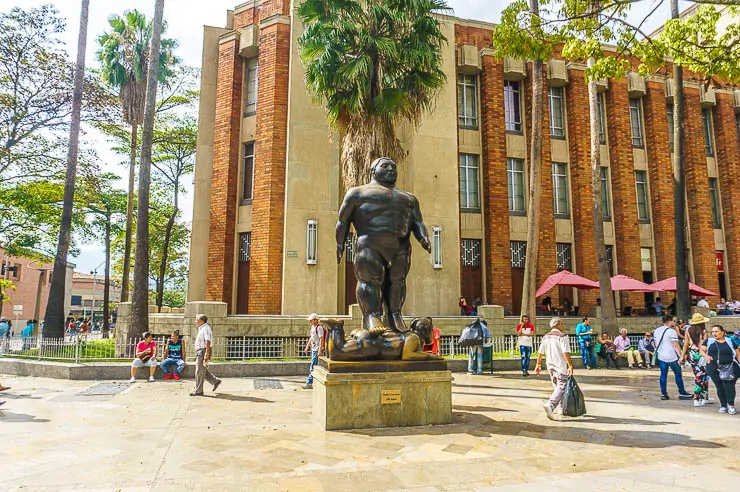
Beyond that though, I think the whole No Shorts and No Flip Flops thing is totally overblown. Truth is, you’ll see locals wearing shorts and flip-flops here in their local barrios.
It’s almost a sort of game for me at times where I will count how many locals I see dressed like that when I’m out. The other day on the bus I counted nine people out and about in like five minutes…
That being said, locals do tend to dress up a lot more than your average traveler. There’s a big difference between shorts and flip-flops and someone dressed like an Argentinean busker with mangy dreads, dirty clothes, and filthy feet in sandals about to fall apart. Don’t go for the homeless look.
On the flip side, you also don’t want to dress up too fancy because if you look like you’ve “got money” then you can often become a target for thieves.
Your best bet is to go middle of the road… Bring along some nice shorts, wear t-shirts all the time if you want, bring along a pair of decent jeans or long pants. That’s all you need.
Women tend to dress up even more here, but you can most definitely wear open-toe shoes or sandals and wear those tank tops or similar shirts. Many local women do so as well, just with lots of accessories, make-up, and a little bit of plastic surgery.
It’s also important to note that the place or context is also important in terms of what you choose to wear. If you’re going out for a night on the town, yeah, shorts and flip-flops are under-dressed. Nice-ish restaurant, same thing. Fancy mall, you guessed it. Wandering around doing tourist things, who cares?
If you’re the type that tends to get cold easily, then you may also want a light jacket or sweater here to use at night time. On a rare occasion, I will use one, but I’m mostly a nice pair of shorts or pants and a t-shirt kind of guy in the daytime and jeans and t-shirt kind of guy at night time. I almost never need a long sleeve shirt or jacket here for the cold (I’m from Seattle, so it always seems super hot here).
Bring DEET?
You’re going to be heading to the tropics, not far from the Equator… That means jungles and mosquitoes and all sorts of communicable diseases… West Nile, Malaria, Chikungunya, and god knows what else…
Thankfully, mosquitoes are not a big problem here. Medellin isn’t the jungle, and indeed, mosquitoes are actually pretty rare here. I’ve spent years living in Medellin now, and I only see mosquitoes occasionally, usually after a heavy rain, and usually in sectors where there is heavy vegetation or water nearby.
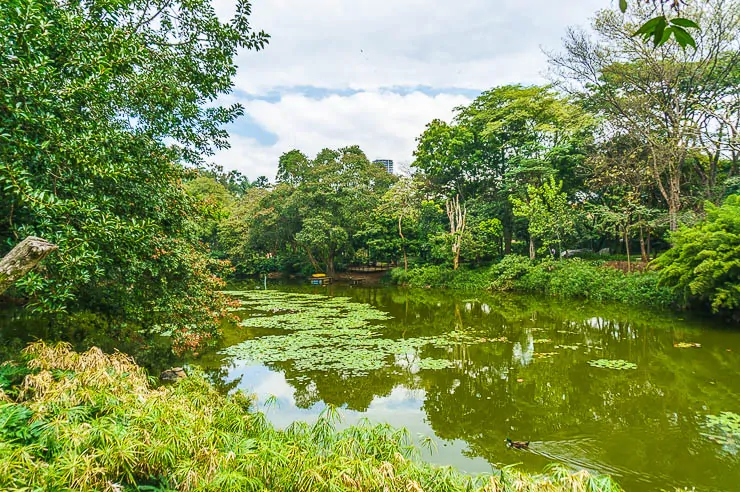
When they do come around, it is usually just one or two coming through your window in the evening, and not like a swarm or never-ending nightmare like other parts of the world (I’m looking at you, Cancun). If you’re in a place where the windows shut completely or have screens, you’ll probably never even see a mosquito during your trip.
Even so, from all the research and accounts I’ve read, the mosquitoes here don’t pose a significant risk of communicable diseases… That is something more common on the coast or in the jungle. Those types of diseases in Medellin aren’t a worry thanks to its climate and altitude.
Here’s the CDC malaria map for Colombia, you’ll notice there is NO known risk in the entire area surrounding Medellin.
Don’t Drink the Water?
If there is one thing almost every traveler has heard about traveling to Latin America, it’s that you should NEVER drink the water because you will undoubtedly get sick. Having traveled through virtually all of Latin America myself, this is definitely a good rule of thumb.
But that’s just not true in Medellin. The water quality in Medellin is excellent and is one of the few destinations in Colombia where you CAN actually drink the water without concern.
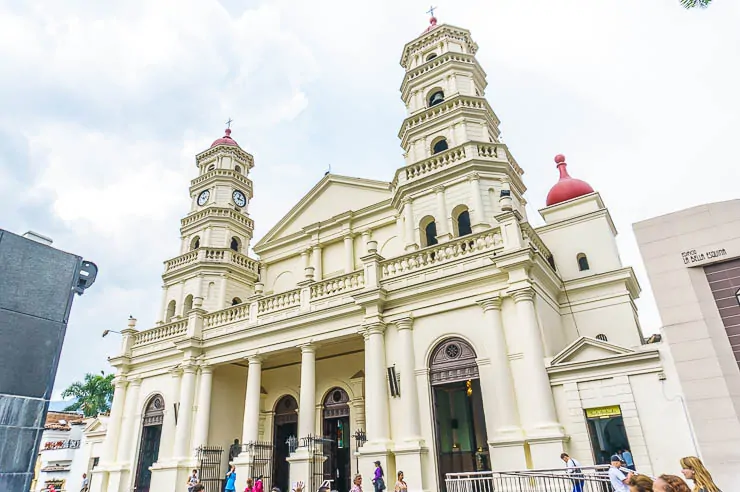
I drink the water all the time, I drank the water when I first got here, and I’ve never had any problems. The tap water in the city is totally safe and quite good unless you are staying in some supremely run-down place with questionable pipes.
Ditch the plastic bottles or water bags for a while and drink the local water… It’s the rest of Colombia where you gotta be cautious. While traveling throughout Colombia and the rest of Latin America, I do keep on hand a small ultraviolet purification device called a Steripen which works great.
How to Handle Your Pesos
Cash is king here in Colombia, so you better get used to handling the Colombian Peso. A few helpful notes: the exchange rate has been around 4,400 pesos per $1 USD. Quick and dirty conversions can be done by dropping three zeros and dividing by three. So 50,000 pesos gives us 50/4, or about $12.
The rate has been getting even better lately, but I still do the above back-of-the-napkin calculations… But prices are actually even cheaper for you in the end! The current official rate for 50,000 is about $11.30 USD.
Money in Colombia
Paper bills are most commonly seen in denominations between 2,000 and 50,000 pesos. Keep in mind that 50,000 peso bills can be difficult to break in most small stores or with small merchants (even with taxi drivers). For one thousand and below, you’re likely to see coins (there is a 1,000 peso note, but it is increasingly rare).
Scams in Medellin
Overcharging or gouging tourists here in Medellin is NOT very common. I’d say that it’s rare, actually. As someone who has lived here for so long, I know prices, and I honestly never see any attempts to overcharge on the street. On the contrary, most local merchants here are overwhelmingly honest and will give you back money even if you accidentally overpay.
When people talk about “gringo prices” here in Medellin, they are generally referring to things like renting apartments or other things more associated with ex-pat life, which can be difficult and thus are made easier for foreigners by charging more.
The one group to watch out for is taxi drivers. They have a bad reputation all over the world, same for Medellin. Thankfully, there are taxi meters here in Colombia that display the price (unlike in other big cities in Colombia), and you can generally tell pretty easily if you are getting the run around in terms of the drive since the majority of most routes have to stick to the few main roads (the Regional, Las Vegas, Av. Poblado, etc).
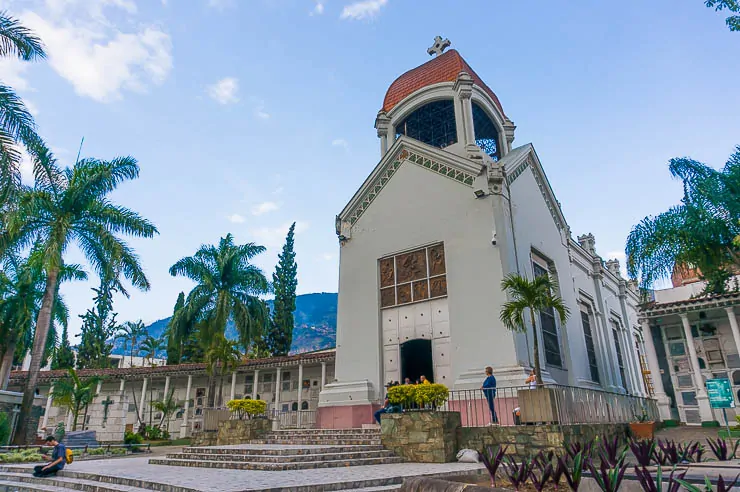
If you are scammed in Medellin it will most likely be by a taxi driver. A good practice is to always pay with exact change (or as close as possible). If you have to pay with a big bill like the 50,000 peso note, try to get into the practice of holding it up to the light and acting like you are examining the bill before handing it over.
The most common scam is a quick switch of a legitimate bill with an obvious fake… Then they play nice guy showing you that you must have been duped, what is wrong with the bill, and how to avoid problems. Then they hand you the fake (when you really gave them a legit bill) and they get another big bill off of you for payment.
ATMs in Medellin
The best practice is to only withdraw money from ATMs inside big box stores or malls. It is best to avoid withdrawing money from the street. Malls are everywhere here, so it is pretty easy.
When you do so, be sure to withdraw a small amount from the ATM rather than carrying around big wads of cash. You get hit with ATM withdrawal fees each time, so that’s why I recommend a bank that will reimburse you for all external ATM withdrawal fees. I use Charles Schwab.
Withdrawing money on the street or taking out big wads of cash is an invitation to problems with robbers. I usually go to the mall, withdraw cash first thing, then wander around for a while.
Anytime you go to larger restaurants, major stores, or bigger hostels/hotels, you should be able to use a travel credit card rather than cash. Do this whenever you can to reserve your cash, just be sure that your credit card has no foreign transaction fees.
Read more about travel banking fundamentals and how I handle money.
Locals Hate Vice Tourism
I wish this one didn’t even have to be said, but there is an ever-growing amount of vice tourism here in Colombia, especially among people traveling to Medellin (when compared to Cartagena or Bogota, for instance).
This vice tourism is mainly from two groups: young dudes who want to engage in drug tourism and old dudes who want to engage in sex tourism. You can skip this section if it doesn’t apply to you.
It’s true that drugs can be cheap and readily found in Medellin, but they are not exactly legal here. Some people even go on tours to cocaine processing facilities, which is just a terrible idea. Prostitution, on the other hand, is actually legal here.
Regardless, both groups of vice tourists are generating increasing bad will or outrage by the locals. There are even public campaigns and signs around town lashing out against both. If you’re in one of those groups of people, you are better off staying at home because they don’t want you here.
First of all, if drugs or prostitutes are your primary motivation for travel, that’s pretty lame, to be honest. Medellin (and Colombia) has so much to offer and it goes well beyond those stereotypes.
Second, know that by doing so, you will dramatically increase your odds of running into big problems here in terms of getting ripped off, robbed, drugged, or even killed (the few foreigners killed here in Medellin are like 90% linked with drug or sex tourism, while the other 10% is resisting a robbery).
Scopolamine druggings (pretty much the most terrifying thing ever) are almost entirely linked to both, although it does also happen while just out having drinks (so never leave your drink unattended).
Third, you give a terrible name to other travelers by doing this stuff. Honestly, I didn’t like Medellin much at first because I was surrounded by a bunch of these horrible tourists like the Russian chick who blew a hole in her nasal passage from doing too much cocaine in Medellin, or the American dude whose afternoon ritual was to go to the whorehouse before hanging out at the bar all night drinking dollar beers (the last part ain’t bad).
Once I got out of that shared living situation and started seeing more of the “real” Medellin, my opinion of the city changed almost instantly.
Look, if what you are wanting to do is illegal in your home country and something you don’t normally do, then Medellin is not the place to do it and certainly not the place to start. This isn’t Thailand or Amsterdam, stuff happens here, seriously.
What to Do
Medellin is not a huge city, physically speaking… But there are nearly three million people crammed into the Valle of Aburra. The size of the city would suggest that you don’t really need to focus highly on trying to coordinate or optimize your visits to different parts of town because you should be able to easily go back or get around the city.
That’s kind of a mistake though, because while the city isn’t big, traffic here is terrible, particularly during rush hour. If you’re going to go explore El Centro or Envigado or wherever you should try to plan a solid itinerary to pack in everything you can in an individual place.
If you’re going by Uber or taxi and you get caught in the morning or early evening traffic, you can expect massive delays. The shape of the valley here and the general infrastructure basically funnels all the traffic into a north-south pattern along just a few roads. Traffic is only growing worse each year.
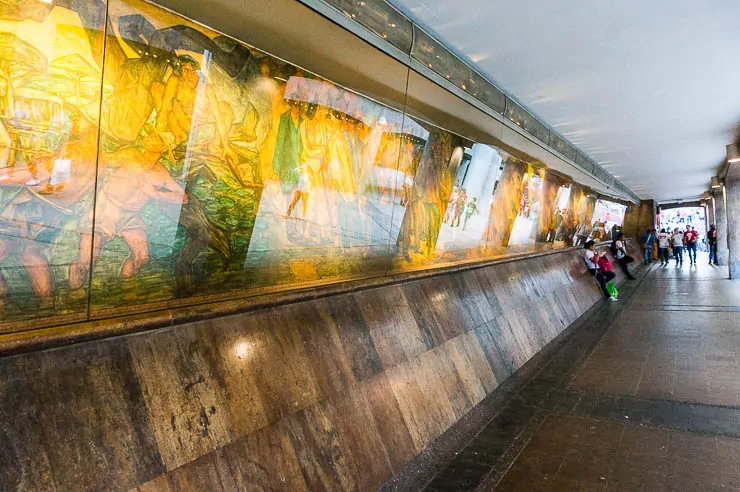
You’re better off taking public transport like the metro, although if you go at rush hour, you should expect tons of people and an almost sardine-like experience. Be sure to watch your pockets and belongings in those situations — pickpockets aren’t super common, but those are the situations to watch out for.
There are a ton of things to do in Medellin, so you shouldn’t be left bored, even if that just means exploring the many awesome restaurants and cafes. But if you’re looking for a more logical way to coordinate your activities, check out my suggested itinerary for 3 days in Medellin.
Organized Tours
I’d also encourage you to do a few organized tours in Medellin to give you a better perspective on the history and culture of this city. A few top choices are:
- Medellin Free Walking Tour in El Centro
- Comuna 13 Graffiti Tour
- Barrio Transformation Tour
- Exotic Fruits Tour
Pablo Escobar Tours
The one tour that you should not do, please, is the infamous Medellin Pablo Escobar tour… Locals hate Pablo and are growing ever more irritated with the tourists flocking to Medellin because of Pablo and the Narcos series on Netflix.
He was a terrorist and patronizing these types of tours only serves to glorify a hated man. You would never go on a Hitler tour so you can take happy selfies at his grave, so I’m not sure why people take Pablo tours in Medellin… Read more about this touchy and complicated subject.
Instead of a Pablo tour, maybe check out one of these other top Medellin tours instead? There are so many options that are much better!
Read more about the best Medellin tours.
Is Medellin Safe?
Medellin is a long way gone from the bad ol’ days of Pablo Escobar, FARC, kidnappings, and all the terrible ways it made the news in the 90s. I’m sure your parents almost fainted and your family told you that you were nuts when you said you were going to Colombia.
Look, things aren’t perfect here, but the bottom line is that Medellin is more or less safe.
Mas o menos…
Bombings and kidnappings and all that is long gone and not of concern, today the main concern is street safety and the potential for robbery.
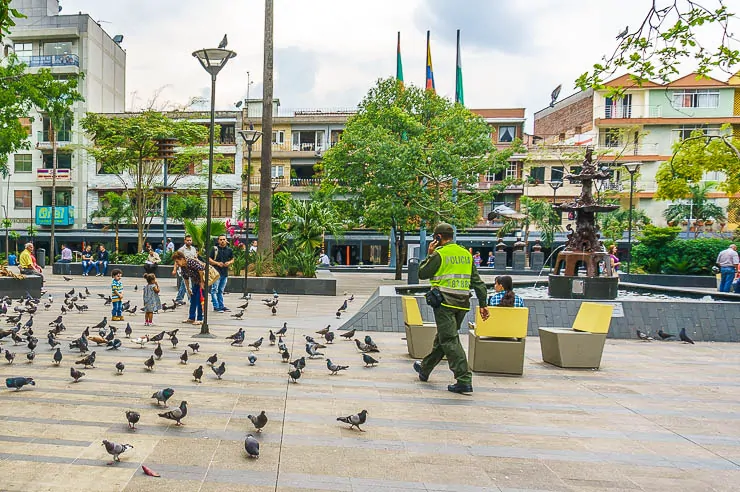
That type of thing is honestly a concern here, but not overwhelmingly so… It is basically the same throughout all of Latin America. If you’ve traveled to any big Latin American city, you probably know the drill, but let’s rehash.
Safety Precautions in Medellin
- Be very careful about showing valuables on the street, especially cell phones. This also applies while in taxis, as mentioned earlier. Cell phones are the biggest targets for thieves who are known to rob at gunpoint for a cell.
- Never, ever resist a robbery. Give them what they want. Not doing so is what causes tourists to get killed here.
- Be very cautious of motorcycles, they are most likely to rob you, rather than some guy on foot. Be especially cautious of two men on one motorcycle.
- Don’t walk around in unfamiliar areas after dark, particularly if there is light foot traffic. Walking back drunk is also a recipe for trouble. This is what they call “dando papaya” or giving Papaya which is basically an invitation for someone to rob you — more on that in a second.
- Unlike the US, it isn’t as simple as saying “avoid the bad neighborhoods” because you are actually probably more likely to get robbed as a tourist in Poblado rather than in El Centro — El Centro has higher crime figures overall, but Poblado is a popular target because that’s where the “rich people” are. To date, the only robbery I’ve witnessed here was on the corner of Parque Lleras at midday on a Sunday.
- Don’t carry around more money than you need for the day.
- Use ATMs only inside large malls or big box stores — avoid taking cash out from ATMs on the street. Take out small amounts of money rather than big withdrawals.
Colombia may not be the best destination for someone entirely new to Latin America, but if you are a bit streetwise and exercise common sense, you’re not likely to become a victim. Indeed, it is rare that something happens.
No Dar Papaya
In Colombia, they have a saying “No Dar Papaya” which means don’t give papaya… Basically, they are trying to say, never offer up papaya (which is anything, really, a cell phone, money, etc) because someone will take papaya if it is “offered” to them.
This is a bit of victim-blaming, unfortunately, but it is ingrained into Colombian life. Never Dar Papaya, else you make yourself an easy mark and a likely target for robbery. It’s better to always lean toward the cautious side here in Medellin or throughout Colombia.
On the whole, people here are very nice, honest, friendly, and want to make sure you have a good time, just don’t provide a window of opportunity to the bad apples that might be out there.
There is still a lot of poverty and huge economic inequality here… Just imagine, the price of the cell phone you are carrying in your pocket is basically a few months of income at minimum wage here (~$250/month for 48 hours of work per week).
Solo Female Travel
Obviously, this is a tricky thing for me as a guy to talk about, so I’ll refer you to this post about solo female travel in Colombia by Adventurous Kate.
I think she gets things mostly right in her article although there does seem to be some outdated or misguided things like the discussion of walking alone after dark as a woman (guys have the same concern since the bad things here are robberies, not sexual assault), or the whole “don’t travel by bus between places,” or “don’t travel by bus at night” thing. Although if your local knowledge and travel experience level is low, it wouldn’t be a bad idea to follow her more conservative advice.
I can speak a little bit about my perspective for female travelers here based on so much time living here, all that I’ve seen on the streets, talking with fellow travelers, and based on the perspective of my girlfriend who is a local Paisa…
Street Harassment: This is something that is generally quite rare. Men here will not hesitate to get a good, long look if they like what they see (leering), but I rarely see things escalate to even the catcall level. Not saying it doesn’t happen, but it happens way less than in places like Italy, for example. From my perspective as a Seattlite, the whole leering thing in Colombia borders on creepy, but what is acceptable differs from culture to culture.
Colombians speak much more affectionately than most may be accustomed to, so don’t mistake “mi amor” from the taxi driver as flirting… That’s just how many speak to women in general, whether it is an older lady or an attractive young woman. I can be sitting there right beside my girlfriend and locals will use terms of endearment like that (which at first struck me as weird). It’s no different than old ladies calling younger guys “mijo”.
Kisses on the cheek between men and women (or women and women, just not between men and men like Argentina), even among people that don’t know each other very well, are also super common. If you ever go to a family event, expect to kiss like a thousand tias on the cheek.
Purses: I would strongly recommend against using a purse at all here, especially the cross-body type. Just put your spending money for the day in your pocket (even get a money clip) as well as your cell phone. Purses can be easy targets for those motorcycle thieves and a grab-and-go theft (which can throw the victim to the ground, causing injuries) is not unheard of.
Travel Insurance for Medellin
I’ve personally never been the victim of a robbery, theft, or any violent crime in Medellin, and that’s after a number of years here and many instances where I was giving papaya (according to my girlfriend). My girlfriend, on the other hand, has firsthand experience this sort of insecurity a few times, but that’s with a lifetime living here.
In any case, it is a very good idea to purchase travel insurance for Colombia and Medellin in order to protect yourself against not just theft, but also illness and injury. I use and recommend World Nomads, and would encourage you to protect yourself while in Colombia, just in case. It’s cheap and offers peace of mind.
Traveling to Medellin?
In any case, I hope these comprehensive travel tips and this guide help you better understand the ins and outs of traveling to Medellin. It is truly a pretty incredible place, I’m excited that you’ve chosen to travel here, and I hope that I’ve helped you get a little more out of your trip.
Traveling to Medellin soon? Be sure to book your lodging today on Booking.com to save. Don’t forget to purchase your travel insurance to protect against illness, injury, and theft. I use and recommend World Nomads.
Share This
Did you enjoy this post about things to know when traveling to Medellin? Please take a second to share it on Pinterest, Facebook, or Twitter. Thanks!
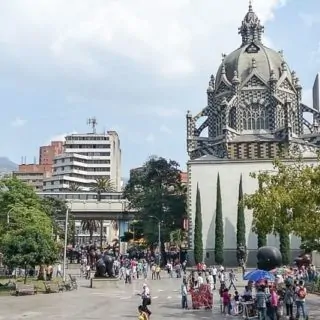
Colombia Travel Tips
Important tips and resources for planning an amazing trip to Colombia, based on my years of traveling and living in Colombia.
Tools
Colombia Trip Planning
Instructions
- Book a cheap flight to Colombia with Momondo, or better yet, start travel hacking so you can fly for free. Traveling between major cities is much better by flying, trust me.
- Plan a rough itinerary and how long you will spend at each destination. Use an itinerary planning service for custom recommendations and pick up Lonely Planet Colombia.
- Work a little every day to teach yourself Spanish, you'll want to know as much as possible before you arrive.
- Book cheap accommodation in advance, at least for the first destinations -- For hostels use: Booking, for cheap hotels use: Hotels.com, for apartments use: Airbnb.
- Reserve your on the ground tours and activities through Get Your Guide.
- Purchase travel insurance for Colombia with SafetyWing to protect yourself from illness, injury, and theft while in Colombia. VERY important. And be sure to read my article: "Is Colombia Safe?" for my honest opinion and safety tips.
- Sign up for my free emails about planning a better trip to Colombia, and be sure to check out my comprehensive guide about traveling to Colombia.
- Learn more money-saving tricks with my top budget travel tips.
- Put together your Colombia packing list.
- Enjoy this incredible country!
Notes
I hope this helped you plan your travels in Colombia! I know it can be a struggle to find accurate and on the ground information when traveling to a new place like Colombia, which is why I started writing so extensively about it!
If you have any questions about Colombia, budget travel, or anything else shoot me an email at ryan@desktodirtbag.com.
(I love getting questions! That is how I get ideas for my blog posts and what to write about!)
Recommended Products
As an Amazon Associate and member of other affiliate programs, I earn from qualifying purchases.
Ryan
Latest posts by Ryan (see all)
- Kazakhstan Food: Exploring Some of its Most Delicious Dishes - August 7, 2023
- A Self-Guided Tour of Kennedy Space Center: 1-Day Itinerary - August 2, 2022
- Fairfield by Marriott Medellin Sabaneta: Affordable and Upscale - July 25, 2022
- One of the Coolest Places to Stay in Clarksdale MS: Travelers Hotel - June 14, 2022
- Space 220 Restaurant: Out-of-This-World Dining at Disney’s EPCOT - May 31, 2022

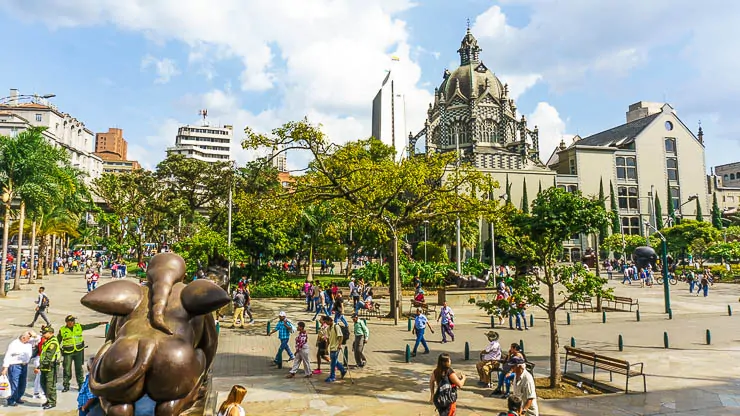
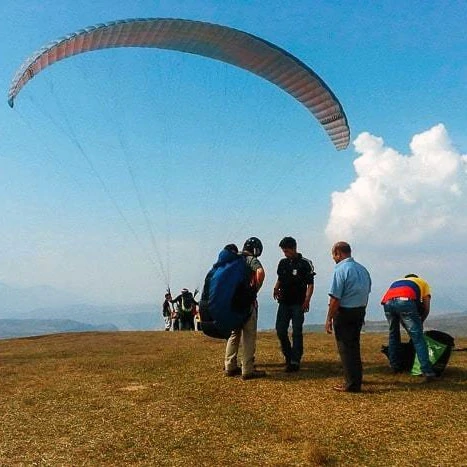
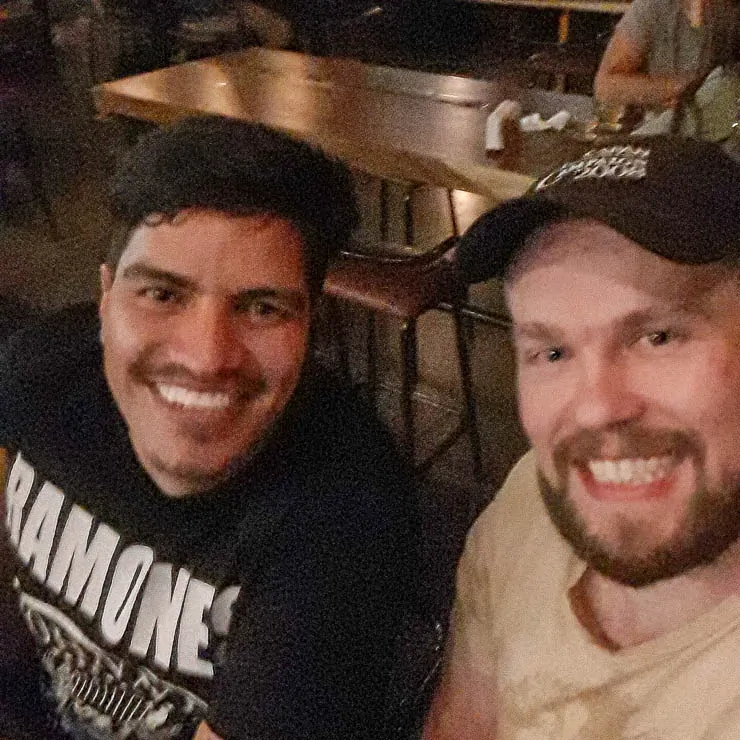
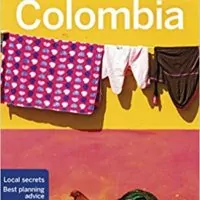
Comments 1
Ryan,
Awesome article.
You are a life-saver.